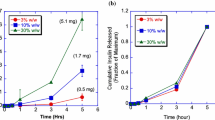Abstract
Purpose. To develop an oral controlled release system for insulin.
Methods. The polymer-inhibitor conjugates carboxymethylcellulose (CMC)-Bowman-Birk inhibitor and CMC-elastatinal were homo- genized with polycarbophil-cysteine conjugate, insulin, and mannitol, compressed to 2 mg microtablets and enteric coated with a polymethacrylate. The protective effect of this delivery system for insulin towards enzymatic degradation, as well as the release profile, was evaluated in vitro. In addition, the effect of the dosage form on glucose levels of diabetic mice was determined.
Results. Tablets containing the CMC-inhibitor conjugates showed a strong protective effect for insulin. Whereas 91.6 ± 7.4% (mean ± SD, n = 3) of insulin in the dosage form without the inhibitor conjugates has been degraded within 3 h of incubation in an artificial intestinal fluid containing physiological concentrations of trypsin, chymotrypsin, and elastase, 49.7 ± 5.5% (mean ± SD, n = 3) of insulin remained stable in the delivery system containing the polymer-inhibitor conjugates. Additionally, polycarbophil-cysteine (PCP-Cys) provides high cohesiveness of the dosage form, due to the formation of inter- as well as intramolecular disulfide bonds within the polymer matrix. According to this, a controlled release of insulin could be achieved over a time period of 10 h. Furthermore, in vivo studies in diabetic mice showed a decrease in basal glucose levels of 20% to 40% during a time period of 80 h.
Conclusions. Mucoadhesive polymer-inhibitor conjugates might represent a promising excipient in delivery systems for oral (poly)peptide delivery.
Similar content being viewed by others
REFERENCES
G. Gwinup, A. N. Elias, and N. D. Vaziri. A case for oral insulin therapy in the prevention of diabetic micro-and macroangiopathy. Int. J. Artif. Organs 13:393–395 (1990).
F. P. Kennedy. Recent developments in insulin delivery techniques: current status and future potential. Drugs 42:213–227 (1991).
Z. Shao, Y. Li, R. Krishnamoorthy, T. Chermak, and A. K. Mitra. Differential effects of anionic, cationic, non-ionic and physiologic surfactants on the dissociation, chymotryptic degradation, and enteral absorption of insulin hexamers. Pharm. Res. 10:243–250 (1993).
T. Nishihata, J. H. Tytting, A. Kamada, and T. Higuchi. Enhanced intestinal absorption of insulin in the presence of sodium 5-methoxysalicylate. Diabetes 30:1065–1067 (1981).
M. Morishita, I. Morishita, K. Takayama, M. Yoshiharu, and T. Nagai. Site-dependent effect of aprotinin, sodium caprate, Na2EDTA, and sodium glycocholate on intestinal absorption of insulin. Biol. Pharm. Bull. 16:68–72 (1993).
E. Ziv, O. Lior, and M. Kidron. Absorption of protein via the intestinal wall. Biochem. Pharmacol. 36:1035–1039 (1987).
S. Fujii, T. Yokoyama, K. Ikegaya, F. Sata, and N. Yokoo. Promoting effect of the new chymotrypsin inhibitor KD-488 on the intestinal absorption of insulin in rats and dogs. J. Pharm. Pharmacol. 37:545–549 (1985).
A. Bernkop-Schnürch, G. H. Schwarz, and M. Kratzel. Modified mucoadhesive polymers for the peroral administration of mainly elastase degradable therapeutic (poly)peptides. J. Controlled Release 47:113–121 (1997).
A. Bernkop-Schnürch, R. Kirchmayer, and M. Kratzel. Synthesis, development and in vitro evaluation of drug delivery systems with protective effect against degradation by pepsin. J. Drug Targ. 7:55–63 (1999).
M. K. Marschütz and A. Bernkop-Schnürch. Oral peptide drug delivery: Polymer-inhibitor conjugates protecting insulin from enzymatic degradation in vitro. Biomaterials 21:1499–1507 (2000).
A. Bernkop-Schnürch, S. Scholler, and R.G. Biebel. Development of controlled drug release systems based on polymercysteine conjugates. J. Controlled Release 66:39–48 (2000).
A. Bernkop-Schnürch, V. Schwarz, and S. Steininger. Polymers with thiol groups: A new generation of mucoadhesive polymers? Pharm. Res. 16:876–881 (1999).
A. Bernkop-Schnürch and S. Steininger. Synthesis and characterization of mucoadhesive thiolated polymers. Int. J. Pharm. 194: 239–247 (2000).
A. Bernkop-Schnürch. The use of inhibitory agents to overcome the enzymatic barrier to perorally administered therapeutic peptides and proteins. J. Controlled Release 52:1–16 (1998).
H. Tozaki, J. Komoike, Ch. Tada, T. Maruyama, A. Terabe, T. Suzuki, A. Yamamoto, and S. Muranishi. Chitosan capsules for colon-specific drug delivery: Improvement of insulin absorption from the rat colon. J. Pharm. Sci. 86:1016–1021 (1997).
J. F. Woodley. Enzymatic barriers for GI peptide and protein delivery. Crit. Rev. Ther. Drug 11:61–95 (1994).
J. L. Cleland, M. F. Powell, and S. J. Shire. The development of stable protein formulations: a close look at protein aggregation, deamidation, and oxidation. Crit. Rev. Ther. Drug 10:307–377 (1993).
M. Baudys, T. Uchio, D. Mix, D. Wilson, and S. Wan Kim. Physical stabilization of insulin glycosylation. J. Pharm. Sci. 84:28–33 (1995).
R. A. Pullen, D. G. Lindsay, S. P. Wood, I. J. Tickle, T. L. Blundell, A. Wollmer, G. Krail, D. Brandenburg, H. Zahn, J. Gliemann, and S. Glameltoft. Receptor-binding region of insulin. Nature 259:369–373 (1976).
A. Bernkop-Schnürch and S. Thaler. Polycarbophil-cysteine conjugates as platforms for oral (poly)peptide delivery systems. J. Pharm. Sci. 89:901–909 (2000).
C.-M. Lehr. Bioadhesion technologies for the delivery of peptide and protein drugs to the gastrointestinal tract. Crit. Rev. Ther. Drug 11:119–160 (1994).
H. Takeuchi, H. Yamamoto, T. Niwa, T. Hino, and Y. Kawashima. Enteral absorption of insulin in rats from mucoadhesive chitosan-coated liposomes. Pharm. Res. 13:896–901 (1996).
Z. Chap, T. Ishida, J. Chou, C. J. Hartley, R. M. Lewis, M. Entman, and J. B. Field. Effect of metabolic clearance rate and hepatic extraction of insulin on hepatic and peripheral contributions to hypoglycemia. J. Clin. Invest. 76:2222–2234 (1985).
Author information
Authors and Affiliations
Rights and permissions
About this article
Cite this article
Marschütz, M.K., Caliceti, P. & Bernkop-Schnürch, A. Design and In Vivo Evaluation of An Oral Delivery System for Insulin. Pharm Res 17, 1468–1474 (2000). https://doi.org/10.1023/A:1007696723125
Issue Date:
DOI: https://doi.org/10.1023/A:1007696723125




